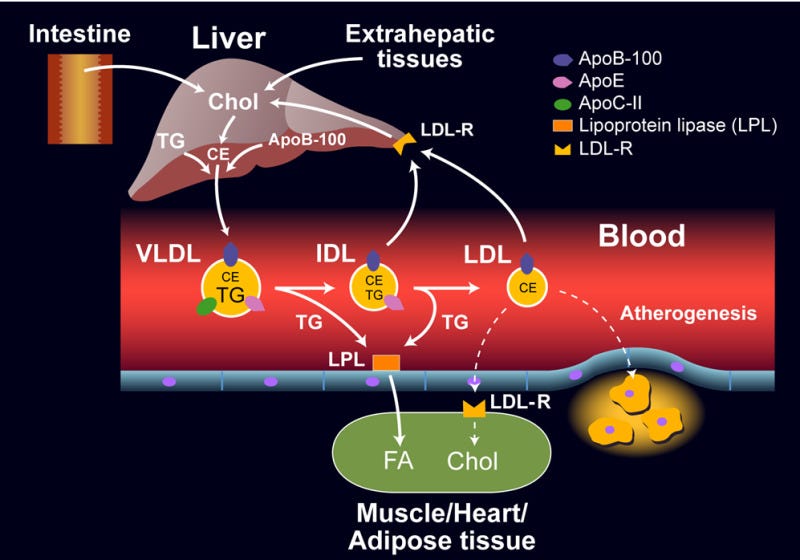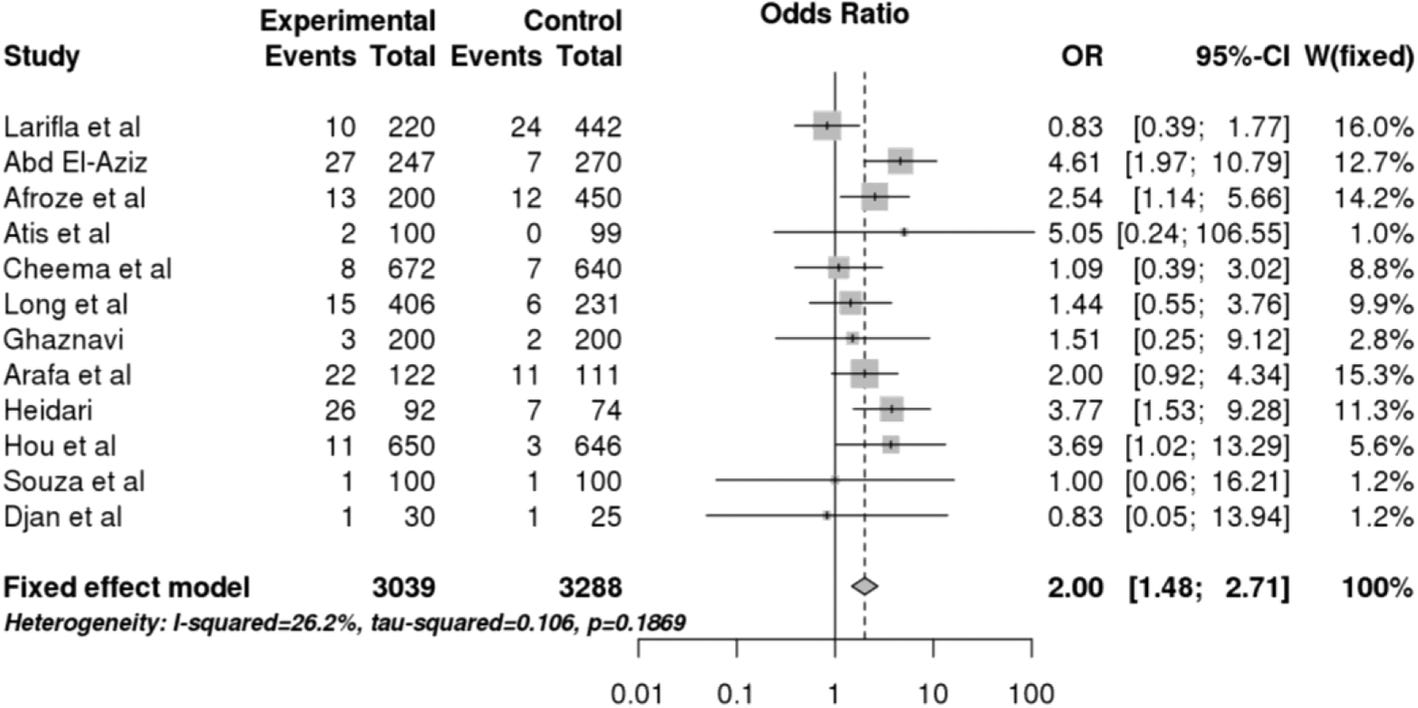APOE4 & Cardiovascular Risk

Being a carrier of the APOE4 gene variant is associated with higher rates of the most common type of dementia, late-onset dementia.
There are three primary variants of APOE - APOE2, APOE3 & APOE4.
Everyone has two separate copies. One inherited from either parent.
As a result, there are six different possible combinations.
APOE 2/2, 2/3, 2/4, 3/3, 3/4, 4/4.
Of those with late-onset dementia, up to 65% are carriers of the APOE4 gene variant1.
15-20% of the population have at least one copy of APOE4, and 2-3% have two copies23.
A subsequent article will focus on the risk of late-onset dementia for those carriers of APOE4.
However
Most people do not appreciate that being a carrier of APOE4 significantly increases the risk of cardiovascular disease also.
The APOE protein is located on the lipoprotein particle.
Every lipoprotein particle has one APOB protein. (**Please note the B)
When we measure APOB levels, this is what we are measuring to give an estimate of the number of cholesterol particles and the subsequent risk of cardiovascular disease.
APOE is also centrally involved in cholesterol metabolism.
In general, for an APOB particle to be cleared from circulation, it attaches to an LDL receptor in the liver and is cleared from circulation.
i.e. LDL-Cholesterol/APOB goes down.
For those with defective LDL receptors, as seen in familial hyperlipidemia, APOB particles are not cleared effectively, and concentrations rise, causing atherosclerosis4.
When the liver produces a lipid particle, it is first a VLDL, then becomes an IDL, and then an LDL particle, as shown in the image below5.

Here is the rub when it comes to APOE and cardiovascular risk.
Each of the particles (VLDL, IDL & LDL) has an APOB protein (The Blue Dot).
Only the VLDL & IDL particles have an APOE protein (The Pink Dot).
Both can attach to the LDL receptor in the liver to be cleared.
However…
Those with an APOE4 variant mean that the LDL receptor binds to APOE with about 20 times the affinity than the APOB protein6.
As a result, the LDL cholesterol particles with an APOB are not taken up by the liver as all the LDL receptors have been used up to bind the VLDL & IDL particles.
This results in higher circulating levels of LDL particles.
Which increases the risk of atherosclerosis.
APOE4 & Cardiovascular Risk
We now know that carriers of APOE4 typically have higher circulating APOB levels, but the question is how much this influences the risk of cardiovascular disease.
Multiple studies have examined this question, and in general, carriers of the APOE4 gene are about twice as likely to develop coronary artery disease compared to those who are not carriers of the APOE4 gene variant7.

But is there anything you can do to reduce this additional risk?
The answer is yes.
But you need to tread carefully.
It is also why I went into detail explaining ‘why’ risk increases due to the binding of APOE to LDL receptors in the liver. (I know you found it confusing because it is confusing; it took me a long time to get my head around it too, but it’s worth understanding).
In simple terms, if the issue is that we just need more LDL receptors to clear the APOB particles, then we just need a way to do that.
Here’s how.
Statin therapies reduce LDL cholesterol concentrations in two ways8.
-
They reduce the synthesis of cholesterol in the liver.
-
They up-regulate the number of LDL receptors in the liver.
More LDL receptors, less APOB, less cardiovascular risk.
But there is a wrinkle.
Very low levels of desmosterol, a cholesterol synthesis marker, are often lower in those with Alzheimer’s dementia, and these low levels could be seen as a risk factor for this condition9. This is primarily based on observational data, but the association nonetheless exists.
Using statin therapy at high doses can overly suppress cholesterol synthesis and also desmosterol levels, thereby theoretically increasing the risk of dementia.
What to do?
Thankfully, statin therapies are not our only tool for lowering LDL cholesterol and APOB concentrations.
Ezetimibe, which lowers LDL-C and APOB concentrations by reducing intestinal cholesterol absorption, also up-regulates LDL-C receptors in the liver10.
But so, too, do many other lipid-lowering therapies, including bempedoic acid, PCSK9 inhibitors and inclisiran1112.
My approach, in general, is to introduce non-statin lipid-lowering therapies early in the management of patients with elevated APOB who are also carriers of the APOE4 gene variant.
I do not routinely test for desmosterol levels, primarily because of access to testing, but if you can access this test in consultation with a clinician who is familiar with interpreting the data, it could be a useful additional metric to follow.
Testing for APOE4
Most medical centres can easily test for the APOE4 gene variant using a simple blood or saliva test, and this is the recommended way to evaluate for any APOE4 gene variants.
Direct-to-consumer genetic testing services, such as 23&Me, also report on APOE4 gene status. In general, testing should be formally conducted in a certified laboratory, and direct-to-consumer saliva testing should be avoided in light of the potential for miscalls of variants.
Main Takeaways
Most people are aware of the increased risk of late-onset dementia with APOE4 gene variants but are much less aware of the cardiovascular risk.
Reducing this excess risk is possible using existing therapies, but the approach to doing so needs to be done carefully, given the possibility of over-suppression of cholesterol synthesis.
When possible, I assess the APOE4 gene status of my patients, but access to formal testing can be a challenge.
So if you want a more comprehensive view of your cardiovascular risks, assessing your APOE4 gene status might be something to consider.
Just ensure your risk is managed wisely.
https://www.alz.org/alzheimers-dementia/what-is-alzheimers/causes-and-risk-factors/genetics#:~:text=APOE%2De4%20is%20the%20first,%2De2%20and%20APOE%2De3.
Mahley RW. Apolipoprotein E: from cardiovascular disease to neurodegenerative disorders. J Mol Med (Berl). 2016 Jul;94(7):739-46. doi: 10.1007/s00109-016-1427-y. Epub 2016 Jun 9. PMID: 27277824; PMCID: PMC4921111.
Sienski G., et al. APOE4 disrupts intracellular lipid homeostasis in human iPSC-derived glia. Sci Transl Med. 2021 Mar 3;13(583):eaaz4564. doi: 10.1126/scitranslmed.aaz4564.
De Castro-Orós I, Pocoví M, Civeira F. The genetic basis of familial hypercholesterolemia: inheritance, linkage, and mutations. Appl Clin Genet. 2010 Aug 5;3:53-64. doi: 10.2147/tacg.s8285. PMID: 23776352; PMCID: PMC3681164.
Feingold KR. Introduction to Lipids and Lipoproteins. [Updated 2021 Jan 19]. In: Feingold KR, Anawalt B, Blackman MR, et al., editors. Endotext [Internet]. South Dartmouth (MA): MDText.com, Inc.; 2000-. Available from: https://www.ncbi.nlm.nih.gov/books/NBK305896/
Mahley RW. Apolipoprotein E: from cardiovascular disease to neurodegenerative disorders. J Mol Med (Berl). 2016 Jul;94(7):739-46. doi: 10.1007/s00109-016-1427-y. Epub 2016 Jun 9. PMID: 27277824; PMCID: PMC4921111.
Ashiq, S., Ashiq, K. The association of apolipoprotein-E (APOE) gene polymorphisms with coronary artery disease: a systematic review and meta-analysis. Egypt J Med Hum Genet22, 16 (2021). https://doi.org/10.1186/s43042-021-00135-2
Goldstein JL, Brown MS. The LDL receptor. Arterioscler Thromb Vasc Biol. 2009 Apr;29(4):431-8. doi: 10.1161/ATVBAHA.108.179564. PMID: 19299327; PMCID: PMC2740366.
Sato Y, Suzuki I, Nakamura T, Bernier F, Aoshima K, Oda Y. Identification of a new plasma biomarker of Alzheimer's disease using metabolomics technology. J Lipid Res. 2012 Mar;53(3):567-576. doi: 10.1194/jlr.M022376. Epub 2011 Dec 27. PMID: 22203775; PMCID: PMC3276481.
Ezetimibe Increases Endogenous Cholesterol Excretion in Humans. Arterioscler Thromb Vasc Biol. 2017 May;37(5):990-996. doi: 10.1161/ATVBAHA.117.309119.
Jialal I, Ramakrishnan N. Bempedoic acid: a novel oral LDL-cholesterol lowering agent. Int J Physiol Pathophysiol Pharmacol. 2022 Apr 15;14(2):84-89. PMID: 35619668; PMCID: PMC9123472.
Advantages and Disadvantages of Inclisiran: A Small Interfering Ribonucleic Acid Molecule Targeting PCSK9-A Narrative Review. Cardiovasc Ther. 2022 Feb 10;2022:8129513. doi: 10.1155/2022/8129513.




